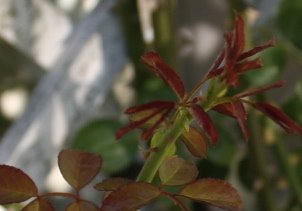This was a challenging year for container plants. The sedums have happily survived the summer's fluctuations in rainfall, thanks to a well-drained clay pot.

However, an iron planter of Salvia farinacea "Blue Victoria" never had an opportunity to flaunt its drought tolerance, being totally flooded out in early summer. Wetter and wiser, I switched to clay pots, just in time for this change in the weather.
Surviving on the front step is this pot of purple fountain grass Pennisetum setaceum "Rubrum," assorted coleus, fuchsia "Gartenmeister Bonstedt," and the barely in control sweet potato vine Ipomoea batatas "Margarita."

I have very strong opinions about what plants belong in containers--no, nyet, nein to the cliche of red geraniums or big blossom petunias. Don't get me started. The growing season is too short!




